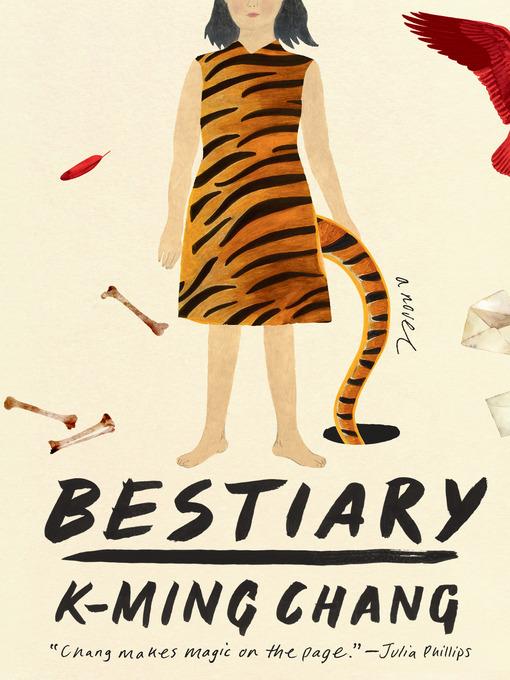
Bestiary
A Novel
کتاب های مرتبط
- اطلاعات
- نقد و بررسی
- دیدگاه کاربران
نقد و بررسی

June 15, 2020
In Chang’s vivid, fabulist debut, three generations of women contend with the mythology of their Taiwanese heritage. Chang opens in 1980, with Mother as a young girl searching for the gold her father brought from mainland China to Taiwan to Arkansas, then flashes forward to present-day California, where Mother raises Daughter on a steady stream of legends, such as that of Hu Gu Po, a tiger spirit who wants to be human but must consume the toes of children to keep her form. (Some of Mother’s toes are missing.) Daughter takes the story of Hu Gu Po as her own when she grows a tiger tail from a wound on her back, the result of a whipping Mother gave her and her brother for digging holes in their front yard. When Daughter befriends a classmate from China, the girls explore their desire for each other, as the holes in her front yard spit up letters that seem to be written by Daughter’s grandmother, leaving it up to Daughter to make sense of her lineage. The narrative arc meanders through the characters’ various relationships, but the prose is full of imagery. Chang’s wild story of a family’s tenuous grasp on belonging in the U.S. stands out with a deep commitment to exploring discomfort with the body and its transformations.

July 1, 2020
In a Taiwanese immigrant family, secrets and myths are indistinguishably intertwined. This debut novel is told from the alternating perspectives of three generations of women from the same family: Ama, the grandmother, who emigrated from Taiwan with her war-addled husband and two children, leaving three other daughters behind; Mother, who remembers both Taiwan and the Arkansas chicken farm where they arrived through the lens of poverty and struggle; and the daughter, born in this country, who serves as a link between her mother and grandmother which both would be more comfortable severing. From the beginning, the story is one of internalized violence. Agong, the family patriarch, was a soldier from the Chinese mainland, 20 years older than Ama when she married him at 18, already a widow and mother of three. In their second life in America, Agong has lost the thread of his memories and forgotten his name, the faces of his children, and the place where he buried the family gold--in spite of Ama's best efforts to beat it out of him. Mother, in an attempt to escape Ama's violence, has married another man from the Chinese mainland and struggles instead to shield her children from her husband's abuse. Meanwhile, the daughter navigates both the demands of her American community to assimilate and the need of her immigrant family to preserve the cultural memories of a place she has never known. The magic of these origin myths is very much present in all their lives. When the daughter and her brother dig a series of holes in the rank soil of their backyard, the holes become mouths, open and hungry. When the daughter is beaten for this infraction by her mother--enacting a violence more typical of Ama--a tiger tail with its own vituperative will grows from one of the scabs. And when the daughter's lover, Ben, a girl from Ningxia who could "spit a watermelon seed so far it skipped the sea and planted in another country," gets the idea to feed the daughter's tail to one of the backyard holes, what emerges are letters from Ama that tell not only the secret at the root of her violence, but the secret at the root of all their entangled lives. A visceral book that promises a major new literary voice.
COPYRIGHT(2020) Kirkus Reviews, ALL RIGHTS RESERVED.

August 1, 2020
At almost 19, Ama already has a dead soldier husband and three daughters. She marries two-decades-older Agong, another soldier with whom she has two more daughters. The youngest becomes Mother, who moves with Ama, Agong, and Jie (older sister), from Taiwan to Arkansas, only to be displaced again when the family relocates to California. Mother marries a Chinese husband (who leaves) and births two children of her own. The eldest, Daughter, turns mythical when she and her brother dig holes in the backyard that morph into hungry portals of (mis)understanding. Raw, angry, even sneering, Ama, Mother, and Daughter's three-voiced narrative is often breathtaking: Ma doesn't measure her life in years but in languages . . . Each language was worn outside her body, clasped around her throat like a collar. The agile, abundant beauty of Chang's phrasing, however, is not quite enough to mitigate the relentless abuse, dysfunction, and violence that permeates her debut. Storytelling?lost legends, fairy tales, family lore, cryptic letters?is used to frighten and control, which eventually turns stifling enough to potentially estrange less patient readers.(Reprinted with permission of Booklist, copyright 2020, American Library Association.)

























دیدگاه کاربران